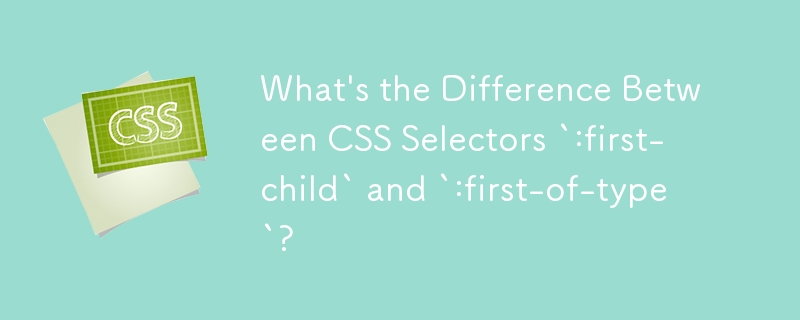 Web Front-end
Web Front-end
 CSS Tutorial
CSS Tutorial
 What's the Difference Between CSS Selectors `:first-child` and `:first-of-type`?
What's the Difference Between CSS Selectors `:first-child` and `:first-of-type`?
What's the Difference Between CSS Selectors `:first-child` and `:first-of-type`?

Elucidating the Distinction between :first-child and :first-of-type
Despite their seemingly similar definitions, :first-child and :first-of-type differ significantly in their selection criteria. To achieve a comprehensive understanding, let's explore the nuances that set them apart.
First-Child vs. First of Type
:first-child identifies the first element of any type within its parent element. On the other hand, :first-of-type specifically targets the first element of its own type within its parent element.
Consider the following HTML snippet:
<div class="parent"> <div>Child 1</div> <div>Child 2</div> <p>Paragraph</p> </div>
In this example, the selector '.parent > div:first-child' would match the element with the text "Child 1" because it is the first child of the '.parent' element. Meanwhile, the selector '.parent > div:first-of-type' would also match "Child 1" because it is the first element of the 'div' type within the parent.
Implications of the Distinction
:first-child prioritizes the order of children within the parent element, while :first-of-type focuses on the element's type regardless of its position among its siblings. This distinction can have ramifications in scenarios where the child elements belong to different types.
If the first child in our example is replaced with an 'h1' element, the :first-child selection would still target it. However, :first-of-type would now match the first 'div' element, effectively skipping the 'h1' due to its different type.
Summary
To summarize, :first-child represents the first child regardless of type, while :first-of-type specifically targets the first element of a specific type. This distinction enables greater flexibility and precision in selecting HTML elements based on their position and type within the parent element.
The above is the detailed content of What's the Difference Between CSS Selectors `:first-child` and `:first-of-type`?. For more information, please follow other related articles on the PHP Chinese website!

Hot AI Tools

Undresser.AI Undress
AI-powered app for creating realistic nude photos

AI Clothes Remover
Online AI tool for removing clothes from photos.

Undress AI Tool
Undress images for free

Clothoff.io
AI clothes remover

Video Face Swap
Swap faces in any video effortlessly with our completely free AI face swap tool!

Hot Article

Hot Tools

Notepad++7.3.1
Easy-to-use and free code editor

SublimeText3 Chinese version
Chinese version, very easy to use

Zend Studio 13.0.1
Powerful PHP integrated development environment

Dreamweaver CS6
Visual web development tools

SublimeText3 Mac version
God-level code editing software (SublimeText3)

Hot Topics
 1664
1664
 14
14
 1423
1423
 52
52
 1317
1317
 25
25
 1268
1268
 29
29
 1242
1242
 24
24
 Google Fonts Variable Fonts
Apr 09, 2025 am 10:42 AM
Google Fonts Variable Fonts
Apr 09, 2025 am 10:42 AM
I see Google Fonts rolled out a new design (Tweet). Compared to the last big redesign, this feels much more iterative. I can barely tell the difference
 How to Create an Animated Countdown Timer With HTML, CSS and JavaScript
Apr 11, 2025 am 11:29 AM
How to Create an Animated Countdown Timer With HTML, CSS and JavaScript
Apr 11, 2025 am 11:29 AM
Have you ever needed a countdown timer on a project? For something like that, it might be natural to reach for a plugin, but it’s actually a lot more
 HTML Data Attributes Guide
Apr 11, 2025 am 11:50 AM
HTML Data Attributes Guide
Apr 11, 2025 am 11:50 AM
Everything you ever wanted to know about data attributes in HTML, CSS, and JavaScript.
 A Proof of Concept for Making Sass Faster
Apr 16, 2025 am 10:38 AM
A Proof of Concept for Making Sass Faster
Apr 16, 2025 am 10:38 AM
At the start of a new project, Sass compilation happens in the blink of an eye. This feels great, especially when it’s paired with Browsersync, which reloads
 How We Created a Static Site That Generates Tartan Patterns in SVG
Apr 09, 2025 am 11:29 AM
How We Created a Static Site That Generates Tartan Patterns in SVG
Apr 09, 2025 am 11:29 AM
Tartan is a patterned cloth that’s typically associated with Scotland, particularly their fashionable kilts. On tartanify.com, we gathered over 5,000 tartan
 How to Build Vue Components in a WordPress Theme
Apr 11, 2025 am 11:03 AM
How to Build Vue Components in a WordPress Theme
Apr 11, 2025 am 11:03 AM
The inline-template directive allows us to build rich Vue components as a progressive enhancement over existing WordPress markup.
 A Comparison of Static Form Providers
Apr 16, 2025 am 11:20 AM
A Comparison of Static Form Providers
Apr 16, 2025 am 11:20 AM
Let’s attempt to coin a term here: "Static Form Provider." You bring your HTML
 While You Weren't Looking, CSS Gradients Got Better
Apr 11, 2025 am 09:16 AM
While You Weren't Looking, CSS Gradients Got Better
Apr 11, 2025 am 09:16 AM
One thing that caught my eye on the list of features for Lea Verou's conic-gradient() polyfill was the last item:



